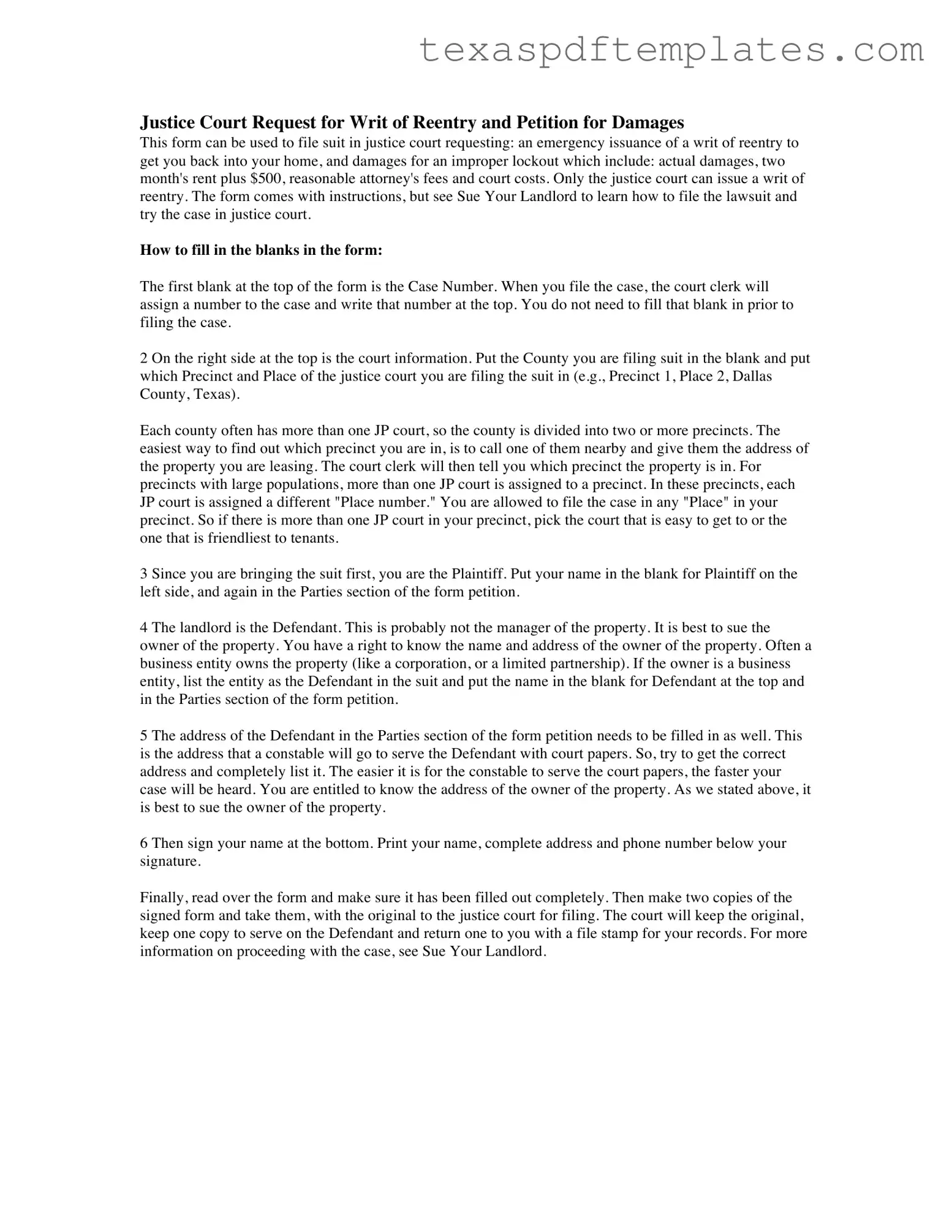Justice Court Request for Writ of Reentry and Petition for Damages
This form can be used to file suit in justice court requesting: an emergency issuance of a writ of reentry to
get you back into your home, and damages for an improper lockout which include: actual damages, two month's rent plus $500, reasonable attorney's fees and court costs. Only the justice court can issue a writ of reentry. The form comes with instructions, but see Sue Your Landlord to learn how to file the lawsuit and try the case in justice court.
How to fill in the blanks in the form:
The first blank at the top of the form is the Case Number. When you file the case, the court clerk will assign a number to the case and write that number at the top. You do not need to fill that blank in prior to filing the case.
2 On the right side at the top is the court information. Put the County you are filing suit in the blank and put which Precinct and Place of the justice court you are filing the suit in (e.g., Precinct 1, Place 2, Dallas County, Texas).
Each county often has more than one JP court, so the county is divided into two or more precincts. The easiest way to find out which precinct you are in, is to call one of them nearby and give them the address of the property you are leasing. The court clerk will then tell you which precinct the property is in. For precincts with large populations, more than one JP court is assigned to a precinct. In these precincts, each JP court is assigned a different "Place number." You are allowed to file the case in any "Place" in your precinct. So if there is more than one JP court in your precinct, pick the court that is easy to get to or the one that is friendliest to tenants.
3 Since you are bringing the suit first, you are the Plaintiff. Put your name in the blank for Plaintiff on the left side, and again in the Parties section of the form petition.
4 The landlord is the Defendant. This is probably not the manager of the property. It is best to sue the owner of the property. You have a right to know the name and address of the owner of the property. Often a business entity owns the property (like a corporation, or a limited partnership). If the owner is a business entity, list the entity as the Defendant in the suit and put the name in the blank for Defendant at the top and in the Parties section of the form petition.
5 The address of the Defendant in the Parties section of the form petition needs to be filled in as well. This is the address that a constable will go to serve the Defendant with court papers. So, try to get the correct address and completely list it. The easier it is for the constable to serve the court papers, the faster your case will be heard. You are entitled to know the address of the owner of the property. As we stated above, it is best to sue the owner of the property.
6 Then sign your name at the bottom. Print your name, complete address and phone number below your signature.
Finally, read over the form and make sure it has been filled out completely. Then make two copies of the signed form and take them, with the original to the justice court for filing. The court will keep the original, keep one copy to serve on the Defendant and return one to you with a file stamp for your records. For more information on proceeding with the case, see Sue Your Landlord.
NO. _________________
(filled in by court)
_________________________________, |
) |
IN THE JUSTICE COURT |
PLAINTIFF (Your Name), |
) |
|
vs. |
) |
|
|
) |
PRECINCT ___, PLACE ___ |
|
) |
|
_________________________________, |
) |
|
DEFENDANT (Landlord). |
) |
_________ COUNTY, TEXAS |
PLAINTIFF'S ORIGINAL PETITION AND EMERGENCY APPLICATION FOR
WRIT OF REENTRY
TO THE HONORABLE JUDGE OF THE COURT:
Plaintiff files this original petition and emergency application for writ of reentry in the above-styled and numbered cause, and in support, shows the Court as follows:
I.DISCOVERY
1.Plaintiff intends to conduct discovery under Level 1.
II.PARTIES
2.______________________, Plaintiff, is a resident of the county of this Court, within Texas.
3.______________________, Defendant, may be served at the following address:
_________________________________________________________________.
III.JURISDICTION AND VENUE
4.The amount in controversy is within the jurisdictional limits of this Court, and venue is proper as the cause of action arose in the county of this Court within Texas.
IV. FACTS
5.Plaintiff leased premises from Defendant.
6.Defendant locked Plaintiff out of the premises in violation of Section 92.008 of the Texas Property Code and Defendant has been unable to regain entry.
Plaintiff's Original Petition and Emergency Application for Writ of Reentry -- Page 1
V. CAUSE OF ACTION
7.Defendant is liable to Plaintiff for improperly locking out Plaintiff. Pursuant to Section 92.008 and 92.009 of the Texas Property Code, Plaintiff requests the Court issue a writ of reentry to allow Plaintiff to regain entry to the premises; and two times the monthly rent plus $500, actual damages, and court costs from
Defendant.
VI. REQUEST FOR RELIEF
Plaintiff requests this Court grant the following relief:
a.writ of reentry be immediately issued and executed;
b.two times the amount of the rent, plus $500;
c.actual damages;
d.court costs; and
e.any other relief to which Plaintiff is entitled.
Respectfully submitted,
__________________________
(Your Signature)
__________________________
(Your Printed Name)
__________________________
(Your Address)
__________________________
(Your City, State, Zip)
__________________________
(Your Phone Number)
Subscribed and sworn to before me this ____ day of ________________, 20___.
__________________________
Notary Public, State of Texas
Plaintiff's Original Petition and Emergency Application for Writ of Reentry -- Page 2
